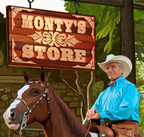Hi all
.
I have been reading "From My Hands To Yours" and have come across the story of "Timber" in the "Into Pressure Syndrome" chapter.
.
For those who don't have the book, Timber was frightened in a low-roofed trailer which caused him to thrust his head up into the roof and injure the back of his skull. As a result of that he developed a phobia about passing under things above his head. The Into Pressure characteristics of the horse makes them want to go into the scary thing, which caused Timber to WANT to bash his head on things above him when he passed under them. He would not go into his stall or Monty's round pen and when he did go under something he tried to hit it with his head.
.
I am wondering if anyone on the Uni has dealt with a horse like that? I have seen horses rush through gates and things like that, but I have never seen a horse try to hurt its self like this.
.
This is an amazing phenomenon that seems so illogical to me as a human, but it also highlights the importance of understanding the behaviour of the horse so that we can help them and work with them more effectively.
.
What do you guys think?
.
Monty Roberts did work with Timber and helped him overcome his phobia - which is great :-)
.
Kind regards,
.
Gen
← back
Horse Behavior and Training
The story of "Timber" - Into Pressure Syndrome

Rewards
Subscribe to Equus Online University and become a part of Monty's worldwide mission to leave the world a better place for horses and for people too.
Students automatically gain access to special rewards, such as exclusive discounts at the Monty Roberts Online Shop. Visit Monty Roberts Online Shop.



Hi Gen
I have never had a horse like that or even heard of a horse like that, I hope you can get help soon.
Meghan
Hi Meghan
.
Thanks for your comment :-) Hopefully this isn't a common thing. But its very interesting.
.
I should also correct my statement about the horse trying to hurt himself; he is actually trying to prevent the horrible roof hurting him by going to it, in his view if I have understood the Into Pressure Syndrome correctly.
.
Thanks again :-)
.
Kind regards,
.
Gen
Hi Gen,
I was lucky enough to be at Flag is up Farms, when the videos of Abigail/Centaur series were made and I've seen this headshy mare hurt her head, when she was being loaded for training. This was part of her trauma, so her reaction was "into pressure", because she had not learned anything else yet. When her owner (the one that rescued her! ) came to pick her up, after all training was done, she stepped into the trailer without any problem. Like when riding, the yielding to pressure has to be learned. Nobody had been able to do this kind of training with her before. It is not that they try to hurt themselves, their instinct tells them to go into where the pressure comes from.
Hope this helpes,
Miriam
Hi Miriam
.
Thanks for your post. It must have been amazing to be a Flag Is Up Farms for the filming of Abigail's lessons! She has come so far.
.
I think I am understanding this better now...
.
Kind regards,
.
Gen
Hi Miriam and Gen,
So.... is it right, that when something happens like that, it looks for a horse like a thread? Like I attack you before you attack me?
Cheers, May.
Hi May
.
Yeah, the horse seems to push into or lean or throw itself into what ever is scaring it or has caused it pain or from where the horse percieves the pressure to be coming from - because that's what their instinct tells them to do in order to reduce the potential for injury to themselves.
.
Would that be correct Miriam?
.
I wonder if its more of a defence than an attack? Because, if I am understanding this correctly, the horse seems to think the thing they are going into is attacking them; when in Timber's case, its just an inanimate object above his head (he doesn't know that though).
.
Until I read about Timber in From My Hands to Yours, I didn't realise how the "Into Pressure Syndrome" could so seriously affect the horse's behaviour. I am understanding more about Abigail now too since Miriam's post. Just amazing. There must be many horses out there that could have been better helped if this phenomenon was more understood by the wider horse training community.
.
I shared Timber's story with one of my "Traditional" horse training friends and they had never considered that "Into Pressure" could result in this kind of behaviour. They were quite amazed by his story and how Monty Roberts dealt with it. They confided that if Timber were theirs, they probably would have sent him to the doggers because they would not have known what to do with him as they had never come across such a situation. Also I have to add in their defence, they are not bad people, and that decision would not have been made lightly - it would only have been made if they felt that they had no other choice.
.
They are now more interested in what I'm learning here too, which is good :-) We had a really good discussion about it.
.
Very interesting...
.
Kind regards,
.
Gen
Hi Gen and Miriam,
This is such a good question, Gen and it gave me again food for thought and questions!! haha... I read this Timber subject as well, after Miriams explanation and I didn't think of what you where wondering, Gen. I relised the same what you said, that it was a strange reaction in humans eyes.
Can you remember the question I asked you, Miriam, about into pressurezone at Maggies question at the forum; Join-up with a Shetland Pony??
What I understand, there is a pressurezone and one horse can have a bigger zone then an other horse, Miriam, you explained to me.
Oké, now I also understand it is his nature to defend himself for the danger/thread. "Before you are attacking me I will defend myself".
So here I am with my questions!!!:
1) has one horse by nature, (breed) a smaller/bigger
pressurezone then an other horse?
2) Is a pressurezone when a foal is born, because he
is protected by his mother, small, but after a while the
foal will develope this? If I listen to Monty in his
lesson "into pressure" he says that young horses (green
ones) will sometimes in the beginning not go into
pressure.(If I understand this right.)
3) When a foal/horse is abused will that pressurezone be
bigger then a not abused foal/horse?
4) Is it possible that a foal/horse can immediatly go into
a pressurezone when it is abused to prevent him from
danger, what ever it is?
5) When a horse learns something new, like let's say;
walking near a gate and he doesn't want to do that
because it is new and scarry/spooky are we talking then
also about pressurezone or about decision-zone?
6) We know that horses are flight animals. But if I am
correct about question 5, is it possible there is a
combination in pressurezone and decision zone?
Underneath Miriam explains:
=the "awareness-zone", where they realise your being around them
=the decision-zone, in which they decide to stay or to flee
=the pressure-zone
If I read this I would think there is a snowball effect. Or how do you say that? It is overlapping.
The horse sees something (awareness-zone), decite what to do (decision-zone) and take action on this (pressure-zone.)
6) Is it true what I think; THAT'S why it is so importened
to imprint a foal in it's first hour of life? So the
foal will be aware of us and all the new thing's in it's
first hours?
So it gives the foal more confidence and that it will
develope a smaller pressurezone?
7) Is it possible that the mother can imprint the
foal "wrong" things because she was abused or by
expeirences and want to protect her foal for
the "danger"?
Oh help, what a questions? Hope you can find the time to answer these. And that I am not confusing things.
Hope you will help me out.
Thank you and have a nice weekend.
Cheers, May.
Hi Gen and May,
I guess this is going to be my longest post, OK here we go!
- Gen, let's go to the pictures in "From my Hands..", you see the dogs attacking the horse's flank, the horse being aware of the risk of being ripped open, should he flee, so he waits until the dog needs to re-ajust it's grip, then he tries to kick the dog away. As long as the dog attacks, the horse tries to keep the damage as small as possible by going "into pressure". This is never an attack, always a defense.
Monty's experience with the starting-gate is based on the same principle: the horse feels attacked by the rails at the inside of the gate( where the jockey puts his feet) and goes "into pressure". The blanket that Monty designed protects the horse from this contact.
-May,
1/ a mustang will have a bigger pressurezone than a familyhorse, based on the difference in need to use their survivalinstinct. Most horses that are used for ridinglessons only notice a person approaching them when it's touching them. It can be very difficult to come into the pressurezone of a wild mustang (remember Shy Boy!)
2/ if you watch a foal and it's dame, when a person tries to touch the foal, it'll be a real artist in hiding behind it's mother. This is also avoiding that someone comes into the pressurezone.
If I read your question right about young horses not going in to pressure, their instinct tells them to go into it, by training they learn to yield to it. So any untrained horse would go into pressure his whole life.
3/ sure, the decisionzone would keep any intruder out, the horse would flee before the "preditor" could hurt him again.
4/ a horse's natural reaction for survival is flight, if this is not possible, they will have to fight.
In this case go into pressure. Being a reactive animal, a horse will in general try to flee and not attack. The pressurezone should be seen as something passive, the intruder comes uninvited, it's not the horse coming into someone else's personal space.
5/ a new spooky thing that provokes a refusal-reacting in a horse, will do this in the decisionzone.
Think of a horse that sees a tractor coming towards him on a countryroad, the awarenesszone start there where the horse notices a scary thing approaching. The decisionzone starts there where the horse tries to run away from the tractor. If you keep it from running and the tractor comes into the pressurezone, chances are that the horse will search the contact with the tractor, for fear of being hurt, hurting himself. This is one of the reasons we have to use the horse's capacity of desensitizing, otherwise they'd keep running for ever.
6/imprinting newbornfoals is so succesfull (if done properly ), because the foal will bond with whatever moves and is above him in the first hour of it's life. This way it'll not lose it's mother in the herd, should they have to flee. This "window" in time is open wide at that moment, if only mamma is around at that time, the foal will bond with her only. Should a human use this precious moment, the foal will see humans as part of their herd and natural surroundings. This could imply a smaller pressurezone, because the reasons to "flight or fight" are less.
7/ one of the reasons it's problematic to breed a "difficult" mare is just that, she'll not allow humans near her foal and imprint it with her fear.
What a long story, hope this helps!
Miriam
Miriam
Thanks for the great post. I am clear about the different pressure zones, but never really thought about the fact that horses will move into pressure. Your illustration of the tractor is great because my horse does exactly that. I don't let him flee and he then moves forward to touch the tractor with his nose. I thought I was my leadership and horsemanship that made him do that. WRONG!
Thanks
Cheers
Hi Gen! I have that book too, but I'm not at that particular chapter yet. I had worked around a horse at a stable that I used to ride at that was afraid of facing a certain way when having cross ties due to a traumatic experience, but I've never heard of a horse self-inflicting injury on himself.
Hi Miriam,
What do you mean this helps...??? Ha... THIS IS FANTASTIC!!!!!
Thank you so much for taking the time to answer my questions.
I am going to print this out and put it in my book ; From my hands to yours, if you don't mind.
This makes so much more sence for me. What I wish is that all of us would be more aware of what a horse is doing/reacting before we even start riding lessons.
Starting first with theorylessons before the practice.
Where I had my lessons (at a ridingschool) they didn't tell me anything even how to put the saddle on. The goal was a riding lesson and no explenation what so ever about horses and there nature behaviour. After five lessons I stopped there, because it didn't feel well.
What you said about the tractor, I reconized that. The other day we went out with Renske and a cart. Renske wears those blinckers and I think she can't see a lot. I don't like those things, but Renske wears them for about twelve years now, only when she is in front of the cart. What I think that she only can see what is in front of her and it seems to me that she is looking through a tube.
So that big huge tractor came and she heard him coming and saw it. She was reacting on this (she doesn't like the sound of tractors, also when she doesn't have does blinckers on) and moved a little bit to the right. I asked the man to switch the tractormotor of and I saw Renske more relaxed and looked at the tractor (she was standing still) and then after a few seconds she decided to walk along this big thing.
It is wonderfull now that I see the light with your answers. Awareness-decision-presurezone. It is always there before something will happen, the reaction.
I have to tell you that I relised and saw that behaviour, because she is doing this all the time and sometimes sniffs on things. But I didn't know that this was all about awareness-decision-presurezone.
Like that day, I was introducing her the sponge to clean her face. After showing her the sponge (it was the first time she saw that yellow squary soft thing)awarenesszone and gave her time to make her dicision(zone) on this, she sniffed on it and allowed it into her pressurezone, it was oké. The same with the Duallyhalter and my soapstory about putting her the Dually on after making a mistake to put it upside down on her. That took much longer for her to except it.
I understand more and more now how Monty is training horses for excample with a fear, like being headshy, afraid for plastic etc.etc.
I am very happy with your answers, Miriam and will let it sink in now.
I am glad, Dennis, that you found out about the reaction of your horse.
Hopefully it doesn't give you a "dent" in your pressurezone....(JOKE!!!)
Don't you think it is also your leadership and horsemanship that your horse is reacting like this? You give him the chance not to flee and give him the time to sniff/touch it. How many people do you think will not do this and hurt the horse because he/she is not doing what's told?
Thank you again Miriam and I am sure a lot of us will learn from this and see things with different eyes.
Probably I am coming back on this subject.
Very kind regards, May.
Hi May, thanks so much for asking these questions, and thank you so much Miriam for answering them so well. I don't think anyone minds a long post when its informative or when people are asking good quality questions.
.
This is one of those things that has made a penny drop in my mind for so many reasons, and like May, I think I now need to sit down and digest all this wonderful information to understand it more completely. I also understand the zones a lot better now too.
.
That's funny about your horse Dennis, this 'Into Pressure' thing really is a big eye opener isn't it :-)
.
I'm glad you have "From My Hands to Yours" Horse Addict. I love the book so much and I have found that I can read it over and over again and pick up something I missed the last time - every time. Timber's story was one of those.
.
Miriam, what you have written here has also made me want to ask another question which I will put up as a separate post as I find myself in a bit of a situation I'm not sure how to handle.
.
Thanks so much everyone for helping me understand this topic better.
.
Kind regards,
.
Gen